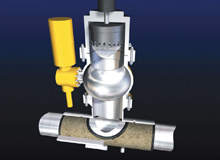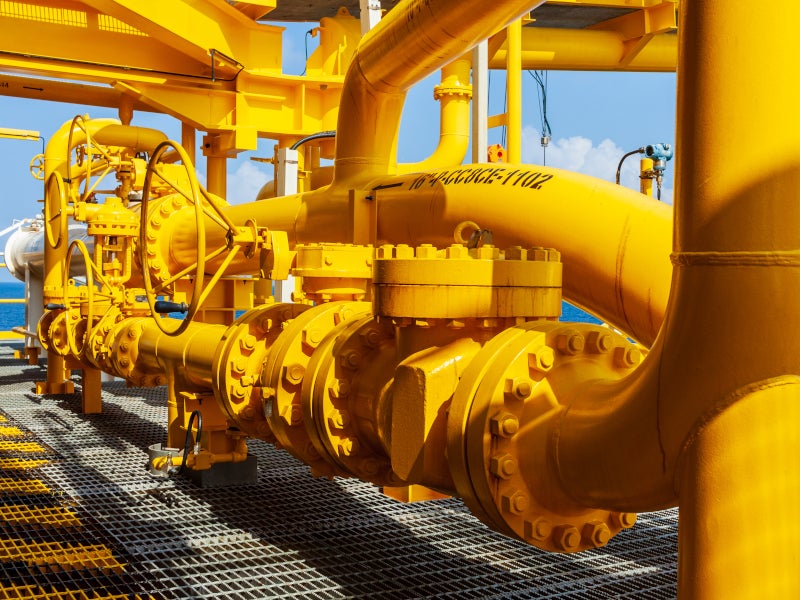
Downtime is the offshore industry’s biggest fear. With oil prices threatening to tip $150 per barrel and increasing pressure on refineries to operate more quickly and efficiently, shutting down pipes for maintenance or modification can cost operators up to £1 million a day in lost revenue and penalty payments.
The solution, according to those in the know, is live pipeline intervention (LPI). The principles of LPI, an umbrella term for the disciplines of hot tapping, line stopping and pipe freezing, have been around for years. Acceptance of the methods has traditionally been slow but, according to Mike Tucker, director of sales at leading LPI company Furmanite, the times are a-changing.
“We’ve been doing LPI work for Shell for 20 years,” he says. “But whereas we might have done a 3in hot tap on a fire hydrant then, we’re now doing 36in hot taps into pipes carrying crude oil. BP, Texaco, Total and all the other majors are using LPI methods too. It’s become a much more acceptable practice.”
So how does live pipeline intervention work? What are the benefits? And how could it help operators make as well as save money?
Hot tapping
See Also:
Hot tapping is a method of boring holes into active pipelines while the system is operating under pressure. Also known as under-pressure drilling, hot tapping can be performed on all types of pipe and typically employs a pressure-containing fitting, a valve, and a drilling or tapping machine to create a new branch connection with no leakage or disruption to the flow of liquid or gas in the system.
How well do you really know your competitors?
Access the most comprehensive Company Profiles on the market, powered by GlobalData. Save hours of research. Gain competitive edge.

Thank you!
Your download email will arrive shortly
Not ready to buy yet? Download a free sample
We are confident about the unique quality of our Company Profiles. However, we want you to make the most beneficial decision for your business, so we offer a free sample that you can download by submitting the below form
By GlobalDataLine stopping
Line stopping is the process of blocking flow through a segment of piping. Also known as line plugging, the process requires a hot tap followed by a mechanical plugging head being inserted into the line, creating a temporary seal and allowing repairs to be completed. The head is then replaced by a completion plug and flange so the pipe can be unblocked safely but the hot tap connection can be re-used easily.
Pipe freezing
During the process of pipe freezing, a jacket is fitted around one or both sections of the pipe that are to be worked on and flooded with liquid nitrogen. With a temperature of -196°C, liquid nitrogen solidifies the contents of the pipe, forming a secure ice plug and allowing intrusive repairs or alternations to be carried out.
Uses
Hot tapping, line stopping and pipe freezing are commonly used to enable emergency or planned repair work to be carried out on a pipeline. The techniques can also be employed to allow flow metres, sampling points, pig indicators or internal visual surveillance equipment to be inserted or modifications such as tying in new branch connections or re-routing lines to be completed while operations continue.
“We can carry out hot tapping on pipes with diameters of up to 42in and line stopping on pipes 70in in diameter,” says Mike Tucker. “At pressures of 100 bar, we can cope with temperatures of 38°C. If you increase the temperature, the pressure has to come down. There’s no limit on how far under the sea we can hot tap, but divers won’t go any lower than 150m.”
Growth
Furmanite’s LPI business has grown by 20% in the past 12 months. Technological advances have allowed companies such as Advantica to design higher quality, more efficient hot tapping, line stopping and pipe freezing equipment at a time when high commodity prices are putting pressure on oil companies to deliver more for less. But the biggest driver, according to Mike Tucker, is education.
“The demand has always been there,” he says. “Technology has helped push things forward, as has the desire for alternatives from the oil companies themselves. The big challenge has been getting people to accept that it is an engineered process. The thought of drilling into a live pipeline is horrifying to people who don’t know the detail of how it works. But gradually, through a process of education, LPI is becoming more accepted around the globe.”
Benefits
The potential benefits of LPI to the oil and gas industry are obvious: reduced downtime equals money savings on revenue and penalties, plus time and hassle saved bringing a disconnected pipe back online.
“When a refinery shuts a pipe down it probably costs them about £1 million a day in lost revenue and penalty payments,” says Mike Tucker. “Plus they have legal obligations to fulfil in terms of producing energy on a daily basis and there are all sorts of technical challenges associated with closing and re-opening a pipe. Typically, one day’s closure means 14 days’-worth of problems. I think it is fair to say that for each pound spent on hot tapping, the customer would save 100 times that amount.”
Challenges
The biggest challenge facing the LPI sector is still consumer confidence. Mike Tucker estimates that of Furmanite’s oil and gas customers, only 50% have so far used LPI methods on their pipelines.
“The biggest problem is that it remains acceptable to close a section of pipeline down for maintenance or modification purposes,” says Mike. “An individual within a company may suggest that hot tapping would be a better method of doing things, but do they want to carry the responsibility for that decision? Often it is easier not to.”
LPI also throws up numerous technical challenges. Dealing with live oil and gas streams, sometimes in challenging underwater environments, raises questions about weight of equipment, pipe pressure and temperature, external water pressure and visibility.
“We have to be selective about where we locate our hot taps,” says Mike. “Irregularities in the pipes can cause problems. If you’re going to weld onto pipes, you need to know how thick they are and what is inside. Has there been internal or external corrosion or erosion? Have there been any deposits? We always identify these things first so we can mitigate any risk.”
Innovation
Designers and manufacturers are constantly striving to evolve their products to make LPI better and more cost effective. The latest innovation is Advantica’s subsea grouted tea (SSGT), developed as part of a joint industry partnership (JIT) with Subsea 7, which is fresh out of research and development, and promises to solve cost and safety problems associated with subsea hot tapping.
“Subsea hot tapping currently requires a team of divers who have been trained to weld underwater,” says Advantica’s Dan Vu, who invented the SSGT. “They have to create a habitat, a dry environment to work in, and it takes them two or three days to do the welding while a support vessel stands by at all times. Before they even go subsea, they have to simulate the expected conditions and gain qualification.
“The SSGT minimises the amount of qualification required because there is no requirement for welding, so you can use construction divers and there is no need to create a habitat. We’re focusing on the North Sea at first, as that is where the SSGT was developed, and we’re hoping that Conocco Phillips, Total and Statoil will use it. The SSGT will allow big savings and is a low-risk operation.”
Outlook
In the next five years, Furmanite’s Tucker expects the LPI sector to grow considerably, with opportunities opening up in developing nations and acceptance becoming more widespread around the world.
“In developing countries and the post-Soviet states it is common for refineries to run at 60% capacity,” he says. “They can close a section for maintenance and it causes no problems. However, as the global players move in – BP is already in Russia – there will be a natural drive towards 100% efficiency, so any technology that can prevent closure to pipelines will be closely looked at. I don’t think LPI will ever be the norm, but within five years it will be a globally accepted option.”
Advantica’s Vu thinks that live pipeline intervention will become more popular as technology such as his own SSGT will help operators to overcome fears and break into new markets.
“Operators are reluctant to do subsea hot tapping because of the qualification required before going underwater,” he says. “In future, as innovations such as the SSGT make this process easier, they will be more willing to hot tap as it will help them to explore marginal fields and open new markets. We are aiming towards developing a totally diverless system, which will allow us to reach 3,000m underwater without anyone having to leave the shore.”




